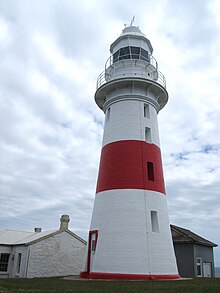Low Head Lighthouse

View of Low Head Lighthouse, looking to the northwest in 2010. Generator sheds are visible behind the tower
|
|
|
Tasmania
|
|
| Location |
Low Head (on Bass Strait) George Town Tasmania Australia |
|---|---|
| Coordinates | 41°03′1.5″S 146°47′22.0″E / 41.050417°S 146.789444°ECoordinates: 41°03′1.5″S 146°47′22.0″E / 41.050417°S 146.789444°E |
| Year first constructed | 1833 |
| Year first lit | 1833 |
| Automated | 1995 |
| Foundation | concrete basement |
| Construction | brick tower |
| Tower shape | cylindrical tower with balcony and lantern |
| Markings / pattern | white tower with red horizontal bands at base and midsection White metal lantern and gallery |
| Height | 19 metres (62 ft) |
| Focal height | 43 metres (141 ft) |
| Original lens | Fresnel lens, Wilkins and Company, London |
| Intensity | 50,000 cd (1000 watt, 240 volt tungsten-halogen lamp) |
| Range | 43 kilometers (23 nmi) |
| Characteristic | Fl(3) W 30s. |
| Fog signal | Type G diaphone, installed in 1929 |
| NGA number | 7088 |
| ARLHS number | AUS–101 |
| Managing agent | Australian Maritime Safety Authority |
Low Head Lighthouse is in Low Head, Tasmania, about 7 kilometres (4.3 mi) north of George Town on the east side of the mouth of the Tamar River. It was the third lighthouse to be constructed in Australia, and it is also Australia's oldest continuously used pilot station. This light is now unmanned and automated.
During the course of their circumnavigation of Van Diemen's Land now Tasmania in the Norfolk in 1798, George Bass and Matthew Flinders made landfall at a place they named Port Dalrymple now George Town, 40 kilometers (25 mi) to the north-west of Launceston. In doing so, they proved the existence of a strait between Australia and Tasmania. Flinders reported difficulty in locating the entrance to the channel.
Colonel William Paterson arrived on 16 February 1804 aboard HMS Buffalo as the newly appointed Lieutenant Governor of Van Diemen's Land with the first settlers. The first navigation marker he installed at Low Head was a simple flagpole in 1804. Later that year, Paterson established a pilot station and signal station in the sheltered bay below Low Head. He also installed a fire beacon at Low Head to mark the hazardous entrance of the Tamar River. When a vessel was sighted after sunset, a fire would be lit and attended all night by convicts to allow the vessel to maintain sight of the port.
Several serious shipping accidents occurred near the mouth of the Tamar River early in the history of George Town. The first and most infamous of these occurred on 15 June 1808, when the Hebe struck a reef between Low Head and Western Head at the entrance to Port Dalrymple. The ship was wrecked on the rocks at the mouth to the Tamar River, which have since that day carried the name Hebe Reef. Responding to this ongoing threat to shipping, the local Committee of Pilotage recommended in 1826 that a lightstation should be built at Low Head.
...
Wikipedia

